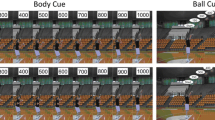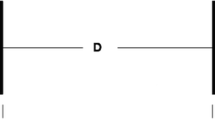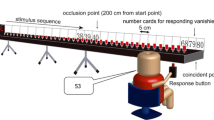Abstract
We provide behavioral evidence that the human motor system is involved in the perceptual decision processes of skilled performers, directly linking prediction accuracy to the (in)ability of the motor system to activate in a response-specific way. Experienced and non-experienced dart players were asked to predict, from temporally occluded video sequences, the landing position of a dart thrown previously by themselves (self) or another (other). This prediction task was performed while additionally performing (a) an action-incongruent secondary motor task (right arm force production), (b) a congruent secondary motor task (mimicking) or (c) an attention-matched task (tone-monitoring). Non-experienced dart players were not affected by any of the secondary task manipulations, relative to control conditions, yet prediction accuracy decreased for the experienced players when additionally performing the force-production, motor task. This interference effect was present for ‘self’ as well as ‘other’ decisions, reducing the accuracy of experienced participants to a novice level. The mimicking (congruent) secondary task condition did not interfere with (or facilitate) prediction accuracy for either group. We conclude that visual–motor experience moderates the process of decision making, such that a seemingly visual–cognitive prediction task relies on activation of the motor system for experienced performers. This fits with a motor simulation account of action prediction in sports and other tasks, and alerts to the specificity of these simulative processes.




Similar content being viewed by others
References
Abernethy, B., Farrow, D., Gorman, A. D., & Mann, D. (2012). Anticipatory behaviour and expert performance. In N. J. Hodges & A. M. Williams (Eds.), Skill acquisition in sport: Research, theory and practice (pp. 288–305). London: Routledge.
Aglioti, S. M., Cesari, P., Romani, M., & Urgesi, C. (2008). Action anticipation and motor resonance in elite basketball players. Nature Neuroscience, 11, 1109–1116.
Anderson, J. R. (1982). Acquisition of cognitive skill. Psychological Review, 89, 369–406.
Balser, N., Lorey, B., Pilgramm, S., Stark, R., Bischoff, M., Zentgraf, K., et al. (2014). Prediction of human actions: expertise and task-related effects on neural activation of the action observation network. Human Brain Mapping, 35, 4016–4034.
Bischoff, M., Zentgraf, K., Lorey, B., Pilgramm, S., Balser, N., Baumgartner, E., et al. (2012). Motor familiarity: brain activation when watching kinematic displays of one’s own movements. Neuropsychologia, 50, 2085–2092.
Blakemore, S. J., & Decety, J. (2001). From the perception of action to the understanding of intention. Nature Reviews Neuroscience, 2, 561–567.
Blakemore, S. J., & Frith, C. (2005). The role of motor contagion in the prediction of action. Neuropsychologia, 43, 260–267.
Bouquet, C. A., Gaurier, V., Shipley, T., Toussaint, L., & Blandin, Y. (2007). Influence of the perception of biological or nonbiological motion on movement execution. Journal of Sports Sciences, 25, 519–530.
Brass, M., Bekkering, H., & Prinz, W. (2001). Movement observation affects movement execution in a simple response task. Acta Psychologica, 106, 3–22.
Calvo-Merino, B., Grezes, J., Glaser, D. E., Passingham, R. E., & Haggard, P. (2005). Action observation and acquired motor skills: an fMRI study with expert dancers. Cerebral Cortex, 15, 1243–1249.
Calvo-Merino, B., Grezes, J., Glaser, D. E., Passingham, R. E., & Haggard, P. (2006). Seeing or doing? Influence of visual and motor familiarity in action observation. Current Biology, 16, 1905–1910.
Cañal-Bruland, R., van Ginneken, W. F., van der Meer, B. R., & Williams, A. M. (2011). The effect of local kinematic changes on anticipation judgments. Human Movement Science, 30, 495–503.
Capa, R. L., Marshall, P. J., Shipley, T. F., Salesse, R. N., & Bouquet, C. A. (2011). Does motor interference arise from mirror system activation? The effect of prior visuo-motor practice on automatic imitation. Psychological Research, 75, 152–157.
Casile, A., & Giese, M. A. (2006). Nonvisual motor training influences biological motion perception. Current Biology, 16, 69–74.
Caspers, S., Zilles, K., Laird, A. R., & Eickhoff, S. B. (2010). ALE meta-analysis of action observation and imitation in the human brain. NeuroImage, 50, 1148–1167.
Christensen, A., Ilg, W., & Giese, M. A. (2011). Spatiotemporal tuning of the facilitation of biological motion perception by concurrent motor execution. The Journal of Neuroscience, 31, 3493–3499.
Cooper, L., & Podgorny, P. (1976). Mental transformations and visual comparison processes: effects of complexity and similarity. Journal of Experimental Psychology: Human Perception and Performance, 2, 503–514.
Craighero, L., Bello, A., Fadiga, L., & Rizzolatti, G. (2002). Hand action preparation influences the responses to hand pictures. Neuropsychologia, 40, 492–502.
Cross, E. S., Hamilton, A. F., & Grafton, S. T. (2006). Building a motor simulation de novo: observation of dance by dancers. Neuroimage, 31, 1257–1267.
Decety, J., Perani, D., Jeannerod, M., Bettinardi, V., Tadary, B., Woods, R., et al. (1994). Mapping motor representations with positron emission tomography. Nature, 371, 600–602.
Ericsson, K. A., & Kintsch, W. (1995). Long-term working memory. Psychological Review, 102, 211–245.
Flach, R., Knoblich, G., & Prinz, W. (2004). Recognizing one’s own clapping: the role of temporal cues. Psychological Research, 69, 147–156.
Fogassi, L., Ferrari, P. F., Gesierich, B., Rozzi, S., Chersi, F., & Rizzolatti, G. (2005). Parietal lobe: from action organization to intention understanding. Science, 308, 662–667.
Gallese, V., & Goldman, A. (1998). Mirror neurons and the simulation theory of mind-reading. Trends in Cognitive Science, 2, 493–501.
Gazzola, V., & Keysers, C. (2009). The observation and execution of actions share motor and somatosensory voxels in all tested subjects: single-subject analyses of unsmoothed fMRI data. Cerebral Cortex, 19, 1239–1255.
Gobet, F. (1998). Expert memory: a comparison of four theories. Cognition, 66, 115–152.
Gobet, F., & Jackson, S. (2002). In search of templates. Cognitive Systems Research, 3, 35–44.
Grafton, S. T. (2009). Embodied cognition and the simulation of action to understand others. Annals of the New York Academy of Sciences, 1156, 97–117.
Grosjean, M., Zwickel, J., & Prinz, W. (2009). Acting while perceiving: assimilation precedes contrast. Psychological Research, 73, 3–13.
Grossman, E. D., & Blake, R. (2001). Brain activity invoked by inverted and imagined biological motion. Vision Research, 41, 1475–1482.
Hamilton, A., Wolpert, D. M., & Frith, U. (2004). Your own action influences how you perceive another person’s action. Current Biology, 14, 493–498.
Hecht, H., Vogt, S., & Prinz, W. (2001). Motor learning enhances perceptual judgment: a case for action-perception transfer. Psychological Research, 65, 3–14.
Hohmann, T., Troje, N. F., Olmos, A., & Munzert, J. (2011). The influence of motor expertise and motor experience on action and actor recognition. Journal of Cognitive Psychology, 23, 403–415.
Hommel, B., Müsseler, J., Aschersleben, G., & Prinz, W. (2001). The theory of event coding (TEC): a framework for perception and action. Behavioral and Brain Sciences, 24, 849–937.
Hubbard, T. L. (2005). Representational momentum and related displacements in spatial memory: a review of the Findings. Psychonomic Bulletin and Review, 12, 822–851.
Iacoboni, M., Moinar-Szakacs, I., Gallese, V., Buccino, G., Mazziotta, J. C., & Rizzolatti, G. (2005). Grasping the intentions of others with one’s own mirror neuron system. PLoS Biology, 3, e79.
Iacoboni, M., Woods, R. P., Brass, M., Bekkering, H., Mazziotta, J. C., & Rizzolatti, G. (1999). Cortical mechanisms of human imitation. Science, 286, 2526–2528.
Ikegami, T., & Ganesh, G. (2014). Watching novice action degrades expert motor performance: causation between action production and outcome prediction of observed actions by humans. Scientific Reports, 4, A6989.
Jackson, R. C., Abernethy, B., & Wernhart, S. (2009). Sensitivity to fine-grained and coarse visual information: the effect of blurring on anticipation skill. International Journal of Sport Psychology, 40, 461–475.
Jackson, R. C., Warren, S., & Abernethy, B. (2006). Anticipation skill and susceptibility to deceptive movement. Acta Psychologica, 123, 355–371.
Jeannerod, M. (2001). Neural simulation of action: a unifying mechanism for motor cognition. NeuroImage, 14, 103–109.
Kilner, J. M., Paulignan, Y., & Blakemore, S. J. (2003). An interference effect of observed biological movement on action. Current Biology, 13, 522–525.
Knoblich, G., & Flach, R. (2001). Predicting the effects of actions: interactions of perception and action. Psychological Science, 12, 467–472.
Knoblich, G., & Prinz, W. (2001). Recognition of self-generated actions from kinematic displays of drawing. Journal of Experimental Psychology: Human Perception and Performance, 27, 456–465.
Lorey, B., Bischoff, M., Pilgramm, S., Stark, R., Munzert, J., & Zentgraf, K. (2009). The embodied nature of motor imagery: the influence of posture and perspective. Experimental Brain Research, 194, 233–243.
Loula, F., Prasad, S., Harber, K., & Shiffrar, M. (2005). Recognizing people from their movement. Journal of Experimental Psychology: Human Perception and Performance, 31, 210–220.
Makris, S., & Urgesi, C. (2014). Neural underpinnings of superior action prediction abilities in soccer players. Social Cognitive and Affective Neuroscience, 10, 342–351.
Mann, D., Dicks, M., Cañal-Bruland, R., & van der Kamp, J. (2013). Neurophysiological studies may provide a misleading picture of how perceptual–motor interactions are coordinated. i-Perception, 4, 78–80.
Mann, D. T., Williams, A. M., Ward, P., & Janelle, C. M. (2007). Perceptual-cognitive expertise in sport: a meta-analysis. Journal of Sport and Exercise Psychology, 29, 457–478.
Miall, R. C., Stanley, J., Todhunter, S., Levick, C., Lindo, S., & Miall, J. D. (2006). Performing hand actions assists the visual discrimination of similar hand postures. Neuropsychologia, 44, 966–976.
Motes, M. A., Hubbard, T. L., Courtney, J. R., & Rypma, B. (2008). A principal components analysis of dynamic spatial memory biases. Journal of Experimental Psychology, Learning, Memory, and Cognition, 34, 1076–1083.
Mukamel, R., Ekstrom, A., Kaplan, J., Iacoboni, M., & Fried, I. (2010). Single neuron responses in humans during execution and observation of actions. Current Biology, 20, 750–756.
Mulligan, D., & Hodges, N. J. (2014). Throwing in the dark: improved prediction of action outcomes following motor training without vision of the action. Psychological Research, 78, 692–704.
Paulus, M., Lindemann, O., & Bekkering, H. (2009). Motor simulation in verbal knowledge acquisition. The Quarterly Journal of Experimental Psychology, 62, 2298–2305.
Pilgramm, S., Lorey, B., Stark, R., Munzert, J., & Zentgraf, K. (2009). The role of own-body representations in action observation: a functional MRI study. NeuroReport, 20, 997–1001.
Pobric, G., & Hamilton, A. F. (2006). Action understanding requires the left inferior frontal cortex. Current Biology, 16, 524–529.
Prinz, W. (1997). Perception and action planning. European Journal of Cognitive Psychology, 9, 129–154.
Prinz, W., & Hommel, B. (2002). Common mechanisms in perception and action: Attention and performance XIX. New York: Oxford University Press.
Ramnani, N., & Miall, R. C. (2004). A system in the human brain for predicting the actions of others. Nature Neuroscience, 7, 85–90.
Reithler, J., van Mier, H. I., Peters, J. C., & Goebel, R. (2007). Nonvisual motor learning influences abstract action observation. Current Biology, 17, 1201–1207.
Repp, B. H., & Knoblich, G. (2004). Perceiving action identity: how pianists recognize their own performances. Psychological Science, 15, 604–609.
Rizzolatti, G., & Craighero, L. (2004). The mirror-neuron system. Annual Review of Neuroscience, 27, 169–192.
Rizzolatti, G., Fogassi, L., & Gallese, V. (2001). Neurophysiological mechanisms underlying the understanding and imitation of action. Nature Reviews Neuroscience, 2, 661–670.
Ruby, P., & Decety, J. (2003). What you believe versus what you think they believe: a neuroimaging study of conceptual perspective-taking. European Journal of Neuroscience, 11, 2475–2480.
Saygin, A. P. (2007). Superior temporal and premotor brain areas necessary for biological motion perception. Brain, 130, 2452–2461.
Schubotz, R. I. (2007). Prediction of external events with our motor system: towards a new framework. Trends in Cognitive Sciences, 11, 211–218.
Schubotz, R., & von Cramon, D. Y. (2003). Functional–anatomical concepts of human premotor cortex: evidence from fMRI and PET studies. Neuroimage, 20, S120–S131.
Schubotz, R. I., & von Cramon, D. Y. (2004). Sequences of abstract nonbiological stimuli share ventral premotor cortex with action observation and imagery. Journal of Neuroscience, 24, 5467–5474.
Schütz-Bosbach, S., & Prinz, W. (2007). Perceptual resonance: action-induced modulation of perception. Trends in Cognitive Sciences, 11, 349–355.
Shepard, R. N., & Cooper, L. A. (1982). Mental images and their transformations. Cambridge, MA: MIT Press.
Springer, A., Brandstädter, S., Liepelt, R., Birngruber, T., Giese, M., Mechsner, F., & Prinz, W. (2011). Motor execution affects action prediction. Brain and Cognition, 76, 26–36.
Springer, A., Brandstädter, S., & Prinz, W. (2013a). Dynamic simulation and static matching for action prediction: evidence from body part priming. Cognitive Science, 37, 936–952.
Springer, A., Parkinson, J., & Prinz, W. (2013b). Action simulation: time course and representational mechanisms. Frontiers in Cognition, 4, 1–20.
Starkes, J. L. (1987). Skill in field hockey: the nature of the cognitive advantage. International Journal of Sport Psychology, 2, 146–160.
Tomeo, E., Cesari, P., Aglioti, S. M., & Urgesi, C. (2012). Fooling the kickers but not the goalkeepers: behavioral and neurophysiological correlates of fake action detection in soccer. Cerebral Cortex, 23, 2765–2778.
Urgesi, C., Savonitto, M. M., Fabbro, F., & Aglioti, M. (2012). Long- and short-term plastic modeling of action prediction abilities in volleyball. Psychological Research, 76, 542–560.
Ward, P., Williams, A. M., & Bennett, S. J. (2002). Visual search and biological motion perception in tennis. Research Quarterly for Exercise and Sport, 73, 107–112.
Williams, A. M., & Davids, K. (1995). Declarative knowledge in sport: a by-product of experience or a characteristic of expertise? Journal of Sport and Exercise Psychology, 17, 259–275.
Williams, A. M., & Davids, K. (1998). Perceptual expertise in sport: Research, theory and practice. In H. Steinberg, I. Cockerill, & A. Dewey (Eds.), What sport psychologists do (pp. 48–57). Leicester: British Psychological Society.
Williams, A. M., & Ward, P. (2003). Developing perceptual expertise in sport. In J. L. Starkes & K. A. Ericsson (Eds.), Expert performance in sports: Advances in research on sport expertise (pp. 220–249). Champaign, Illinois: Human Kinetics.
Williams, A. M., & Ward, P. (2007). Perceptual-cognitive expertise in sport: Exploring new horizons. In G. Tenenabum & R. Eklund (Eds.), Handbook of sport psychology (3rd ed., pp. 203–223). New York: Wiley.
Wilson, M., & Knoblich, G. (2005). The case for motor involvement in perceiving conspecifics. Psychological Bulletin, 131, 460–473.
Witt, J. K., Kemmerer, D., Linkenauger, S. A., & Culham, J. (2010). A functional role for motor simulation in identifying tools. Psychological Science, 21, 1215–1219.
Witt, J. K., & Proffitt, D. R. (2008). Action-specific influences on distance perception: a role for motor simulation. Journal of Experimental Psychology: Human Perception and Performance, 34, 1479–1492.
Wohlschläger, A. (2000). Visual motion priming by invisible actions. Vision Research, 40, 925–930.
Wolfensteller, U., Schubotz, R., & von Cramon, D. Y. (2007). Understanding nonbiological dynamics with your own premotor system. Neuroimage, 36, T33–T43.
Wolpert, D. M., Doya, K., & Kawato, M. (2003). A unifying computational framework for motor control and social interaction. Philosophical Transactions of the Royal Society of London B, 358, 593–602.
Wuhr, P., & Müsseler, J. (2001). Time course of the blindness to response-compatible stimuli. Journal of Experimental Psychology: Human Perception and Performance, 27, 1260–1270.
Yarrow, K., Brown, P., & Krakauer, J. W. (2009). Inside the brain of an elite athlete: the neural processes that support high achievement in sports. Nature Reviews Neuroscience, 10, 585–596.
Zago, M., & Lacquaniti, F. (2005). Visual perception and interception of falling objects: a review of evidence for an internal model of gravity. Journal of Neural Engineering, 2, S198–S208.
Zentgraf, K., Munzert, J., Bischoff, M., & Newman-Norlund, R. D. (2011). Simulation during observation of human actions—theories, empirical studies, applications. Vision Research, 51, 827–835.
Zwickel, J., & Prinz, W. (2012). Assimilation and contrast: the two sides of specific interference between action and perception. Psychological Research, 76, 171–182.
Acknowledgments
This research was supported by funds awarded to the corresponding authors (Hodges) from an NSERC (Natural Sciences and Engineering Research Council of Canada) Discovery grant and from a New Investigator salary award from CIHR (the Canadian Institute for Health Research).
Author information
Authors and Affiliations
Corresponding author
Rights and permissions
About this article
Cite this article
Mulligan, D., Lohse, K.R. & Hodges, N.J. An action-incongruent secondary task modulates prediction accuracy in experienced performers: evidence for motor simulation. Psychological Research 80, 496–509 (2016). https://doi.org/10.1007/s00426-015-0672-y
Received:
Accepted:
Published:
Issue Date:
DOI: https://doi.org/10.1007/s00426-015-0672-y




